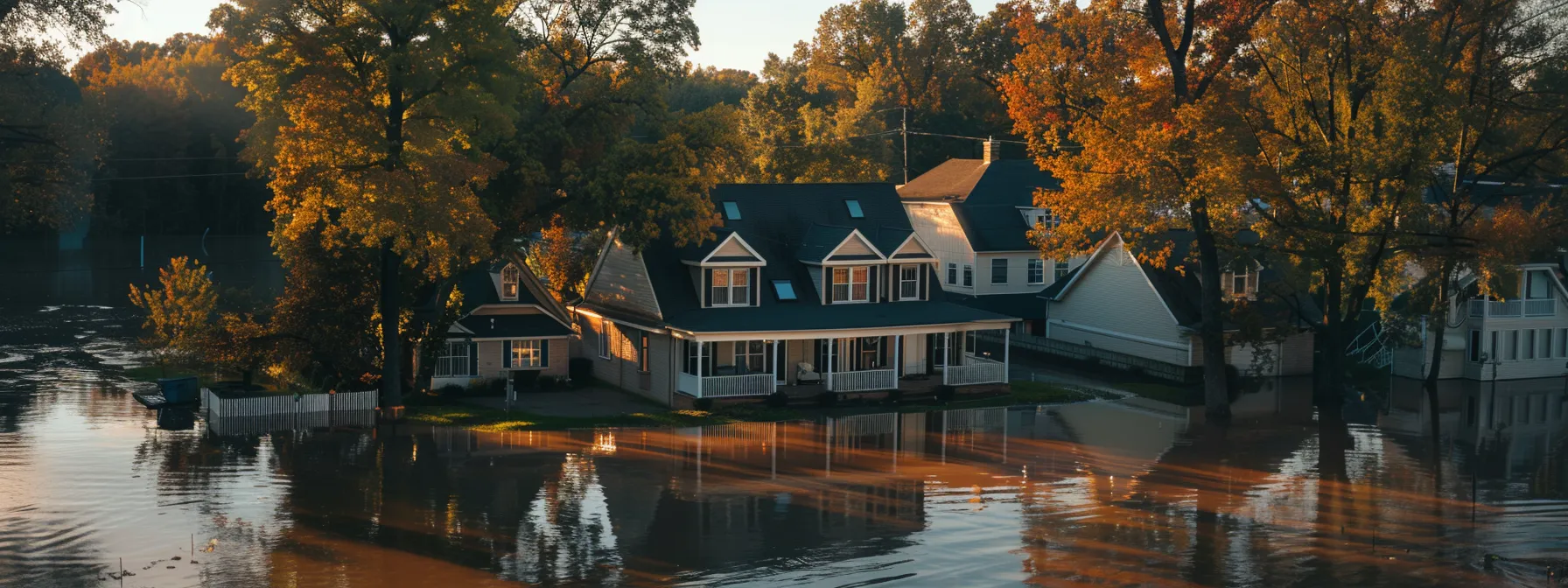Maximizing Flood Insurance Coverage for Georgia Homeowners
Floods in Georgia, while not an everyday occurrence, have the potential to wreak havoc on unsuspecting homeowners. Having the right insurance policy in place is not just comforting—it’s critical.
As I learned the hard way, assuming that your standard homeowner’s policy will cover flood damage can be a costly mistake. That’s why understanding the intricacies of the National Flood Insurance Program (NFIP) is a vital step to securing your home and financial well-being.
In this article, we’ll navigate the often-overlooked aspects of flood insurance in Georgia, including how to evaluate your risk, choose the appropriate level of coverage, and strategies for minimizing your premiums without compromising on protection. Keep reading to unlock insights that could save you thousands and grant you peace of mind in the face of nature’s unpredictable moods.
Key Takeaways
- Flood zone designation is crucial for determining insurance needs and costs
- Historical flood data affects policy premiums and deductible choices
- Balancing coverage limits and deductibles is key for adequate protection
- Annual policy reviews ensure coverage reflects current property value and flood risks
- Compliance with local and federal flood regulations influences insurance coverage and premiums
Understanding Your Flood Risk in Georgia
When I settled into my Georgia home, the revelation that I was in a flood zone came as an unsettling surprise. I discovered that the potential $300 insurance cost I had in mind morphed into an imposing $3,000.
This jarring number sparked my quest to fully grasp flood risks and maximize protection for my home. Delving into the resources provided by the Federal Emergency Management Agency (FEMA) became an early critical step. FEMA flood maps are indispensable for Georgia homeowners, revealing the specific flood zone encircling your property.

With these maps, you can discern the flood risk level your mortgage lender might be looking at and how it influences your requirements for home insurance. Beyond mere compliance, understanding these zones informs smarter choices for both casualty and general insurance, ensuring your coverage is robust against the historical flood data unique to your area.
Indeed, flood insurance is more than a checkbox near your mortgage—it’s about safeguarding your home, finances, and peace of mind amidst nature’s unpredictable temperament.
Review FEMA Flood Maps for Georgia
As I scoured through the FEMA flood maps specific to Georgia, I couldn’t help but consider how vital they are for anyone seeking flood insurance in Georgia. These maps meticulously chart the risk levels associated with different areas, impacting both the necessity and cost of securing a suitable flood insurance policy. Without this valuable insight, any homeowner might be blindsided by both nature’s fury and an inadequate insurance plan.
It became abundantly clear that the labyrinth of flood zones on these maps directly affected the details of the flood insurance policy I’d need for my property. Recognizing the zone in which my home was located allowed me to tailor my policy effectively, preventing any gaps in coverage that could leave us financially vulnerable. For a homeowner in Georgia, these maps are the first layer of defense in fortifying against potential losses: flood map updates
|
Flood Zone |
Risk Level |
Insurance Impact |
|---|---|---|
|
Zone A |
High Risk |
Higher Policy Requirements |
|
Zone B |
Moderate Risk |
Flexible Policy Options |
|
Zone X |
Lower Risk |
Basic Coverage Sufficiency |
Identify Your Property’s Flood Zone
Identifying the specific flood zone where your property resides can feel like navigating a complex water course, yet doing so is essential to ensuring you’re properly shielded from potential water damage. Quick access to current flood zone information is essential, especially when the skies darken and storm warnings echo in the background. This knowledge firmly positions us to engage with insurance agents effectively, advocating for coverage that meets the unique demands of our homes within the floodplain.
Armed with the details of my home’s floodplain location, I approached my insurance needs with eyes wide open, aligning my policy with the guidelines set by local emergency management authorities. It’s like constructing a dam before the storm; by understanding the flood zone designation, I was able to assert preemptive measures against water-related devastations, securing the well-being of my home and financial stability. For more detailed insights, you can explore understanding flood zones.

|
Flood Zone Designation |
Water Risk Level |
Insurance Coverage Nuance |
|---|---|---|
|
My Home’s Zone |
Direct Risk Assessed |
Personalized Policy Adjusted to Risk |
Assess Historical Flood Data in Your Area
My dive into historical flood data had clear financial implications, especially when considering the cost associated with loan agreements. It’s vital to recognize how past flooding events might influence the present and future implications on property insurance premiums and the dreaded deductible.
For instance, if your area has a high claim rate, companies like Liberty Mutual will weigh this history, potentially affecting the cost and terms of your policy. More about how to find flood loss history can provide further insights into these financial aspects.
While evaluating this data, I recognized a pattern where the risk assessment informed the intricate details of coverage options. My discussions with insurance professionals became highly focused on not just the cost but also the value – ensuring my loan and assets were properly shielded by my policy. This historical insight into area-specific flood trends strengthened my ability to choose a deductible that balanced my out-of-pocket expenses with realistic coverage boundaries.
EVALUATING FLOOD INSURANCE OPTIONS IN GEORGIA
Navigating the flood insurance marketplace is akin to ensuring the efficacy of life insurance or the reliability of your home’s air conditioning before the heat of summer strikes—it’s about preparedness for the unforeseeable.
As I weighed my options, the complexities of choosing between the National Flood Insurance Program (NFIP) and private insurers loomed ahead, each with their peculiarities in coverage and price. Scrutinizing coverage limits and deductibles felt as pivotal as the height of my home’s elevation when considering natural disaster resilience.
Through my research, it became clear that the impact of flood zones on insurance not only alters policy premiums but also plays a crucial role in mortgage requirements for insurance coverage. For those with property attributes deemed higher-risk, such as a basement, the investigation into excess flood insurance coverage surfaces as a necessary safeguard to bridge any gaps left by standard policies.
This careful evaluation clarified the comprehensive protection needed for my home, ensuring readiness amidst nature’s uncertainties.
Compare NFIP vs. Private Flood Insurance
As rain patterns shift and flood risks escalate, understanding the nuances between the National Flood Insurance Program (NFIP) and private insurers is pivotal for homeowners in Georgia. The NFIP, with its standardized approach guided by FEMA’s Flood Insurance Rate Map, offers coverage designed to meet the needs of residents across varying flood plains, including those in high-risk areas like Atlanta.
An insurance company operating in the private sector, on the other hand, can provide more personalized coverage options with potentially higher limits and alternative pricing strategies. Yet, their policies bring different conditions, which might converge with or diverge from the NFIP’s offerings, prompting close comparison to determine the most suitable protection for one’s home.
|
Criterion |
NFIP Coverage |
Private Insurance Coverage |
|---|---|---|
|
Guided by |
FEMA’s Flood Insurance Rate Map |
Company-specific risk assessments |
|
Availability |
Standard across flood zones |
Variable, dependent on company policies |
|
Advertising Focus |
Universal eligibility and recovery support |
Customized coverage and competitive premiums |
Analyze Coverage Limits and Deductibles
Discussing coverage limits and deductibles became a focal point in my discussions with the insurance agent, as these elements define the core financial blueprint in the event of flood damage. It’s vital to align these parameters with the value of your home and personal risk appetite to ensure a balance between affordable premiums and adequate protection.
Grasping the intricacies of homeowners insurance coverage allowed me to distinguish between the standard policy and supplementary needs within floodplain management. Assessing this layer helps protect against the financial strain of repairs and replacements, underpinning the security of my investment in my home.
|
Aspect of Insurance |
Consideration |
Impact on Homeowner |
|---|---|---|
|
Coverage Limits |
Alignment with home value |
Ensures full protection against flood damage |
|
Deductibles |
Risk and premium balance |
Affects out-of-pocket costs in a claim |
|
Additional Coverage |
Floodplain management compliance |
Guards against gaps in standard insurance coverage |
Understand the Impact of Flood Zones on Insurance
As a homeowner in Georgia, understanding the correlation between flood zone designation and insurance rates is essential. A casualty insurance company uses this classification as a barometer for policy pricing. Living within a high-risk flood zone means higher premiums as the likelihood of floods impacting your home, and consequently, the insurer’s risk, escalates. It’s a balancing act of risk assessment that directly affects the financial side of protecting personal property.
Conversely, for those in areas of Georgia deemed lower risk, the insurance rates by casualty insurance companies can be more favorable. However, this should not lull homeowners into complacency. Floods can and do occur outside high-risk zones, and protecting your personal property with adequate coverage remains imperative. Gauging this risk and its implication on my insurance cost was a critical step in ensuring my home was both insurable and protected from unpredictable weather patterns.
Mortgage Requirements for Flood Insurance
As an experienced homeowner and flood insurance expert in Georgia, I’ve noticed that your mortgage company will scrutinize your zip code to determine if purchasing flood insurance is mandatory for your investment. This decision is usually based on the property’s location within high-risk flood areas, and it’s a critical aspect of their underwriting process, directly influencing the expense tied to your mortgage terms.
Learning from encounters with fellow homeowners and consultations with insurance specialists, I’m keenly aware that failing to comply with these flood insurance prerequisites can put a mortgage agreement at risk. Lenders are steadfast in requiring adequate flood coverage to protect their investment in your property, and it is on you to ensure that your insurance meets their expert criteria without inflating your financial responsibilities unnecessarily.

Excess Flood Insurance Coverage
Learning the ins and outs of flood insurance brought to my attention the importance of excess flood insurance coverage, especially for properties vulnerable to coastal flooding. This type of policy comes into play when a home’s value surpasses the coverage limits of a standard flood insurance policy, which may not cover all the costs associated with a catastrophic loss.
|
Insurance Aspect |
Standard Flood Insurance Coverage |
Excess Flood Insurance Coverage |
|---|---|---|
|
Home Value |
Up to certain limits |
Exceeds standard policy limits |
|
Coverage for Coastal Flooding |
Limited, particularly for high-value homes |
Higher protection levels for comprehensive security |
|
Personal Finance Protection |
Basic safeguard against flood losses |
Enhanced financial security to cover full restoration costs |
As I explored additional resources for my personal finance planning in the context of flood risk, I came across a comprehensive FAQ section in a PDF provided by The Hartford that illuminated the various nuances of excess flood insurance. This deepened my understanding that beyond the initial insurance policy, taking additional steps to ensure my investment is protected against all eventualities is a prudent financial strategy.
Steps to Maximize Your Flood Insurance Coverage
As I became more attuned to the subtleties of flood insurance, I learned that maximizing coverage isn’t just about signing on the dotted line with a company. It’s about making informed decisions that resonate with the specific needs of your property. By considering strategic increases to coverage limits, we can ensure a buffer against the full scope of potential damage.
Similarly, understanding the financial implications of opting for replacement cost over actual cash value significantly impacts the recovery process after a flood. And let’s not overlook the often-forgotten basements and below-ground areas; adding coverage here addresses the vulnerabilities unique to these spaces.
All of these deliberate steps can transform a basic policy into comprehensive protection, offering a stronger safeguard for your home and assets.
Increase Your Coverage Limits Strategically
When faced with the distinct possibility of flooding, I meticulously assessed the value of my assets to ensure the flood insurance coverage level was adequate. It wasn’t just about meeting the basic requirements; it was crucial to review my policy annually, taking into account any changes in property value or renovations that could affect replacement costs.
Meticulous scrutiny of my home insurance coverage limits led to strategic decisions, such as opting for a higher policy limit to align with the increased equity of my home over time. This impactful choice ensures that, in the face of flood adversity, the foundation of my financial planning won’t be washed away, offering security that my investment is comprehensively covered.
Opt for Replacement Cost Over Actual Cash Value
Selecting between replacement cost and actual cash value for your flood insurance can be likened to placing an advanced security system in your home instead of standard locks. Replacement cost coverage ensures that in the event of a flood, your insurance will cover the full cost of repairing or rebuilding your property to its original condition, without depreciation. This is a pivotal choice that reinforces my financial defenses against flood damage.
It dawned on me that the value of items often depreciates faster than you might anticipate, leading to a significant gap between the actual cash value and what it would cost to buy new. By choosing replacement cost coverage, I secured the assurance that my insurance would meet the total expenses for restoration after a flood, reflecting the true value of my home and possessions:
|
Coverage Type |
Benefit |
Financial Outcome |
|---|---|---|
|
Actual Cash Value |
Lower premiums |
Receive market value at the time of loss |
|
Replacement Cost |
Higher premiums |
Covers the full cost to repair or replace |
Add Coverage for Basements and Below-Ground Areas
Ensuring that our basements and below-ground areas are covered by flood insurance is a critical component that could be easily overlooked. My home, like many in Georgia, features spaces that are partially or fully underground, which are particularly susceptible to flooding; thus, I took the precaution of extending my coverage to include them, safeguarding every square inch of my property.
It was during a careful review of my insurance policy that I realized standard coverage often excludes these vulnerable areas. Promptly, I discussed options with my insurer to supplement my policy, adding explicit protection for my basement, to prevent being caught unprepared by a flood’s repercussions on lower levels of my residence.
Reducing Your Flood Insurance Premiums
Amidst the necessity of selecting comprehensive flood insurance, finding ways to temper the associated costs became a quest of mine. I’ve learned that by proactively implementing flood mitigation measures, I can not only foster a safer living environment but also potentially reduce my insurance premiums.
Taking such proactive steps—like elevating key components of my home, including utilities—further illustrates responsible homeownership. My research into available discounts for flood-resilient measures unveiled opportunities I hadn’t originally considered. Moreover, by carefully reviewing the details of my policy, particularly the deductibles, I gained leverage in managing my overall expenses.
These practices, though they may require an initial investment or effort, stand to create long-term financial benefits for homeowners like myself, by easing the annual financial burden of flood insurance premiums while simultaneously reinforcing my home’s defenses against potential flood damage.

Implement Flood Mitigation Measures
Recognizing the escalating flood risks in Georgia, I took a proactive stance to fortify my home with strategic updates. By installing foundation vents, I facilitated water flow through the building, thereby diminishing the pressure that could otherwise lead to structural damage during a flood event.
I also engaged in conversations with flood mitigation professionals to design a landscape that naturally diverts water away from my property. Sloping the terrain and incorporating native plants that absorb excess water can significantly reduce the likelihood of floodwater encroaching on my home, demonstrating that even small changes can have a considerable impact on flood insurance premiums.
Elevate Your Home or Utilities
Understanding that elevation can be a game changer, I committed to raising my home’s utilities above the expected flood levels. This not only secured the functionality of my heating and electrical systems during a flood but also had the pleasant side effect of reducing my insurance rates, given that the home now faced a lower risk of utility damage from flooding waters.
The true value of elevation struck me when I learned that homes built above the base flood elevation set by FEMA qualify for substantial insurance discounts. By lifting my home’s structure, I not only shielded it from possible flood damage but also positioned myself for long-term savings—a financially smart move for any homeowner mindful of both protection and budget:
|
Home Elevation |
Flood Protection Level |
Insurance Premium Impact |
|---|---|---|
|
Utility Elevation |
High |
Potential Rate Reduction |
|
Structural Elevation |
Maximum |
Significant Savings Over Time |
Research Discounts for Flood-Resilient Measures
Exploring discounts became a vital step in managing my flood insurance costs. I learned that insurance providers often recognize and reward homeowners who integrate flood-resilient upgrades into their dwellings; such initiatives could be met with considerable discounts on premiums:
|
Resilient Measure |
Premium Discount |
Long-term Benefit |
|---|---|---|
|
Foundation Vents |
Up to 5% |
Reduced structural damage risk |
|
Elevated Utilities |
Up to 10% |
Lower risk of utility damage |
|
Improved Drainage Systems |
Varies by provider |
Minimized water ingress |
My conversations with insurance agents confirmed that maintaining adequate documentation of these upgrades is crucial for availing discounts. Keeping a detailed log of all the modifications backed by receipts and certifications not only simplifies the discount application process but also establishes my proactive stance in mitigating flood risk, thus fostering favorable terms with insurers.
Review Deductibles
Adjusting the deductible on my flood insurance policy was another area where meaningful savings emerged. Opting for a higher deductible guaranteed reduced premiums, providing a calculated risk that could lead to considerable cost savings over time.
It was essential to balance the higher upfront cost I could incur in the event of a flood against the annual savings on premiums. This strategic play required careful financial deliberation, designed to establish a deductible that ultimately favored my long-term economic health.
Navigating the Claims Process for Maximum Benefit
It’s clear that having a strong flood insurance policy in place is a cornerstone of sound homeownership in Georgia, but equally critical is knowing how to navigate the post-disaster claims process. I learned—sometimes the hard way—that meticulous documentation of your property and precious belongings is your first line of defense when filing a claim.
Familiarizing yourself with the claims filing timeline ensures you don’t miss any key steps or deadlines, while understanding how to collaborate efficiently with a claims adjuster can have a profound impact on the settlement received.
These steps are essential for homeowners to ensure they are adequately compensated for losses without unnecessary delay or dispute.

Document Property and Possessions Before Floods
Before the waters rise and chaos ensues, I took the proactive step of documenting every inch of my property, including my possessions. This process is not simply about having a list; it’s about capturing the condition and existence of assets before they potentially become damaged or lost in a flood.
Capturing images and compiling a comprehensive inventory became a linchpin in ensuring a smooth claim with my insurance. This meticulous record, easily accessible and updated, proved vital when presenting my case to the insurance adjustor: it made the difference between a straightforward claim and a drawn-out, contentious one.
|
Claim Documentation Step |
Details Captured |
Insurance Benefit |
|---|---|---|
|
Photographic Evidence |
Property condition and assets pre-flood |
Visual proof to substantiate claims |
|
Property Inventory |
Itemized list of belongings and their value |
Faster claims processing and accurate reimbursement |
|
Update Frequency |
As changes occur in property or possessions |
Keeping records current reduces claim disputes |
Understand the Claims Filing Timeline
As a Georgia homeowner grappling with flood insurance nuances, I quickly learned that timing is everything when filing a claim. The moment damage occurs, a clock starts ticking: policies often dictate a specific window within which claims must be reported to the insurance company.
Staying aware of this timeline is not a mere recommendation—it’s a pivotal part of upholding my policy’s terms. Reporting a claim immediately after a flood is essential, but so is following the set protocols for documentation and submission of detailed claims within the prescribed deadlines:
|
Event |
Action Required |
Timeline |
|---|---|---|
|
Flood Event Occurs |
Report Damage |
As Soon As Possible |
|
Claim Preparation |
Document and Compile Detailed Claim |
Within 60 Days of Flood |
This procedural discipline ensures that I can traverse the claims process without facing barriers that could stall or invalidate my claim, maintaining my eligibility for the full benefits my policy promises.
Work With a Claims Adjuster Effectively
Collaborating productively with a claims adjuster was a step I prioritized highly following a flood. By maintaining clear and open lines of communication, I ensured that each assessment was as thorough as possible and that all damages were accounted for in the adjuster’s report.
I also made it a point to walk through my property with the adjuster, clearly discussing the scope of damages and presenting my documentation, which helped us reach a mutual understanding of the situation, paving the way for an equitable settlement.
The Role of a Flood Insurance Agent in Georgia
Embarking on the journey of securing adequate flood insurance, I quickly realized the significant role a seasoned agent plays in the process. The right agent brings much-needed clarity in selecting coverage that not only complies with Georgia’s regulations but also aligns with your personal needs.
A knowledgeable agent adept at customizing coverage proves invaluable, particularly when it involves tailoring policies around the unique topographical and climatic nuances of your locale. Their guidance is not just about crafting robust policies; it extends into vital support through the complexities of the claims process should disaster strike.
An agent’s intimate understanding of local risks and FEMA requirements drastically simplifies what might otherwise be an overwhelming endeavor, grounding the experience in expertise and personalized care.
Selecting a Knowledgeable Agent
Embarking on the flood insurance journey, I learned that a knowledgeable agent is more than just a facilitator; they are critical navigators who guide you through the turbulent waters of policy selection and risk assessment. Their expertise becomes your most trusted asset, as they parse through complex flood zone information and translate it into a language of coverage that’s tailored specifically to your home’s needs.
There’s a certain peace of mind that comes with an agent who not only understands the ins and outs of flood insurance but also appreciates the nuances of Georgia’s floodplains. This level of proficiency is paramount, as their recommendations can be the difference between an adequate policy and one that leaves you exposed when the storm clouds gather.
How Agents Can Help Customize Your Coverage
When striving for optimal flood coverage, a trusted insurance agent becomes invaluable, meticulously tailoring a policy to my home’s specific location and structure. Their ability to dissect the fine print of policies means they can advocate for coverage that envelops every vulnerability of my dwelling, ensuring no aspect of my home is left unprotected.
Armed with local knowledge and a network of insurers, my agent crafted a flood insurance solution that addressed both the property’s value and geographical threats. This personalized attention to detail shields me from generic policy pitfalls and secures my assets against the nuances of Georgian weather patterns: flood risk information on Jackson Lake Georgia
|
Agent Assistance Area |
Customization Benefit |
Homeowner Advantage |
|---|---|---|
|
Local Geographical Knowledge |
Pinpointed coverage tailored to specific risks |
Targeted protection, avoiding overgeneralized plans |
|
Network of Insurers |
Access to diverse policy options and pricing |
Optimized coverage and cost-efficiency |
|
Policy Detail Analysis |
Identification of coverage gaps and overlaps |
Safeguarding against unexpected exposures and costs |
Leveraging Agent Expertise for Claim Support
When the floodwaters receded and the aftermath became my reality, the expertise of my insurance agent was invaluable during the claims process. Their astute navigation through the maze of paperwork and protocol saved me from the additional stress of managing a claim on my own while I focused on rebuilding.
My agent played a pivotal role in articulating the extent of damage to the claims adjuster, ensuring accuracy in every detail. Their advocacy on my behalf meant that my claim was not only heard but given the careful consideration it deserved, leading to a settlement that truly reflected my losses.
Understanding Local Risks
Having a home in Georgia means preparing for weather-related risks that can vary widely, even within the same county. My flood insurance agent plays a critical role, drawing on their knowledge of local conditions to anticipate such risks accurately and ensuring that my policy reflects the specific threats my property faces.
Local expertise from my insurance agent illuminates the patterns of storm surges and river flooding unique to Georgia’s varied landscape. This specialized understanding proved essential in customizing my policy to address the real, localized dangers that standardized policies might overlook.
Annual Review: Keeping Your Flood Insurance Up-to-Date
As the landscape around us shifts and matures, so too does the nature of flood risk, which necessitates an annual review of our flood insurance policies. Each year, I take a moment to reassess the evolving flood risks and the potential need for modifying my coverage.
It’s a time to reflect on any home improvements that have been made, understanding their impact on my existing policy and considering whether these changes warrant enhanced coverage options. A careful examination of increased coverage limits is also a prudent step, ensuring the insurance plan remains in lockstep with the current value of the property.
By staying proactive with these evaluations, I secure not just coverage, but confidence in the protection of my Georgia home.

Assess Changes in Flood Risk and Coverage Needs
Every year, I sit down to review the flood insurance on my Georgia property, knowing that environmental and developmental changes could shift the flood risk landscape. It’s a responsible step to ensure my insurance reflects the most current data and therapeutic barriers, safeguarding my home against the dynamic nature of flood risks.
Recent construction developments or natural alterations in the area, such as riverbed shifts or deforestation, could potentially impact my property’s flood risk profile. Recognizing these shifts is fundamental for adjusting coverage to remain resilient against newly emerging vulnerabilities:
|
Change Factor |
Potential Impact on Flood Risk |
Required Insurance Coverage Adjustment |
|---|---|---|
|
New Development |
Increased runoff could elevate flood risk |
Possible increase in coverage limits |
|
Natural Shifts |
Altered landscape could change water flow |
Reassessment of property’s flood zone status |
Update Your Policy Based on Home Improvements
Home improvements can play a significant role in the evaluation of your flood insurance policy. If you’ve enhanced your property with additions or extensive renovations, it’s essential to update your policy to reflect these changes: this ensures your coverage is adequate for the increased value of your home.
|
Home Improvement Type |
Impact on Home Value |
Recommended Policy Action |
|---|---|---|
|
Room Additions |
Significant Increase |
Adjust Coverage Limits Upward |
|
Major Renovations |
Variable Increase |
Review and Modify Policy Provisions |
Moreover, installing flood-resistant materials or elevating your home could potentially lower your flood risk, which might reduce your insurance premiums. Therefore, keeping your insurance agent informed about any upgrades or alterations is critical: this proactive communication positions you to reap the potential benefits of decreased insurance costs.
Evaluate the Need for Increased Coverage Limits
Annual reevaluations of my flood insurance allow me to verify that the coverage limits accurately reflect the current value of my Georgia home. Considering the upward trend in market values and the potential for property appreciation, my vigilance in this area ensures that my coverage keeps pace with the true cost of restoration and replacement after a disaster.
As transformative events like zoning changes or FEMA map revisions occur, my coverage limits need to adapt. These adjustments protect against underinsurance, which could leave me facing out-of-pocket expenses in excess of what I had planned for:
|
Event Triggering Review |
Insurance Coverage Relevance |
Action Item |
|---|---|---|
|
Property Value Increase |
May exceed current coverage limits |
Reassess and potentially raise coverage limits |
|
Flood Zone Redefinition |
Change in risk assessment |
Update policy to reflect new flood risk category |
Legal and Regulatory Considerations for Georgia Homeowners
As a Georgian homeowner, I’ve learned that navigating the intricate web of legal and regulatory requirements is essential for securing and maintaining effective flood insurance coverage. Georgia’s specific flood insurance regulations and standards set the baseline for what is expected from homeowners in terms of coverage and compliance. Adhering to local building codes and ordinances directly influences policy standing and ensures resilience against flood damage. Meanwhile, a thorough understanding of federal flood insurance requirements is non-negotiable, as it forms the backbone of most insurance policies. Furthermore, familiarizing myself with local floodplain management guidelines not only protects the community but can also afford certain insurance advantages. Keeping abreast of these regulatory elements allows me to operate within the bounds of the law while optimizing my home’s safety and insurance validity.
Georgia’s Flood Insurance Regulations and Standards
Understanding and abiding by Georgia’s flood insurance requirements is an imperative part of homeownership. State standards mandate that any residential buildings located in high-risk flood zones with loans from federally regulated or insured lenders must carry flood insurance.
My adherence to these regulations not only satisfies legal obligations but also ensures that my home is sufficiently protected. Georgia’s insistence on compliance with the National Flood Insurance Program guidelines reflects a commitment to both homeowner safety and fiscal responsibility in the face of natural disasters.
Compliance With Local Building Codes and Ordinances
As a homeowner, I’ve observed the critical interplay between local building codes and the insurability of my Georgia property. Ensuring my home meets or exceeds these established codes not only facilitates its integrity against floods but can also influence my eligibility for lower flood insurance premiums.
Maintaining compliance with local ordinances extends beyond structural necessities; it positions my property as a testament to responsible stewardship. Local building regulations, after all, are designed to minimize potential damage during flooding events, and by adhering to them, I underscore my commitment to safeguarding my home:
|
Local Building Feature |
Regulatory Compliance |
Insurance Benefit |
|---|---|---|
|
Flood-resistant Materials |
Meets Ordinance |
Potential Premium Discount |
|
Elevation Standards |
Exceeds Code |
Improved Insurability |
|
Detached Structures |
Compliant with Zoning |
Broadened Coverage Options |
Understanding Federal Flood Insurance Requirements
Navigating the terrains of federal flood insurance is pivotal, as it directly impacts my coverage scope and compliance. Grasping the mandates set by the National Flood Insurance Program (NFIP) is crucial since this is the body that sets the groundwork for most of my state’s insurance policies, laying out minimum coverage and elevation requirements that my home must meet.
My diligence in understanding these federal requirements is not only key to satisfying lender stipulations but also to obtaining flood insurance tailored to the distinct risks facing my Georgia residence. It’s imperative that I align my policy with these standards to ensure that, in the wake of a flood, I am positioned for a swift recovery, both structurally and financially.
Local Floodplain Management Guidelines
Engaging with local floodplain management guidelines is a critical step for Georgia homeowners like myself, seeking to navigate flood insurance intricacies effectively. These regulations inform the development and usage of land in vulnerable areas, impacting property safety and insurance implications: they often specify permissible construction practices and protective measures that homeowners must implement.
As a proactive measure, I keep myself apprised of any updates to these guidelines, as they can affect insurance coverage eligibility and premiums. By ensuring my property adheres to the latest local floodplain management practices, I not only contribute to minimizing flood damage risk but also position myself to possibly qualify for more favorable insurance terms:
|
Local Requirement |
Floodplain Management Compliance |
Impact on Insurance |
|---|---|---|
|
Construction Standards |
Ensure building practices align with local guidelines |
May lower insurance premiums |
|
Land Use Regulations |
Adhering to restrictions on the development of flood-prone areas |
Eligibility for broader coverage options |
|
Protective Measures |
Implementation of mandated structural protections |
Reduces risk profile, potentially impacting insurance rates |
Conclusion
Maximizing flood insurance coverage is pivotal for Georgia homeowners to ensure robust financial protection against unpredictable natural disasters. By comprehensively understanding local flood risks and aligning coverage to reflect the true value of their property, homeowners can mitigate potential financial losses.
Strategic policy enhancements and adherence to evolving regulations fortify homeowner resilience in the face of flooding.
Ultimately, diligent annual reviews and expert guidance enable homeowners to maintain optimal coverage, securing not just their homes but also their peace of mind.

Information contained on this page is provided by an independent third-party content provider. This website make no warranties or representations in connection therewith. If you are affiliated with this page and would like it removed please contact editor @producerpress.com


.png?width=850&height=478&name=NEW%20Thumbnail%20(24).png)













